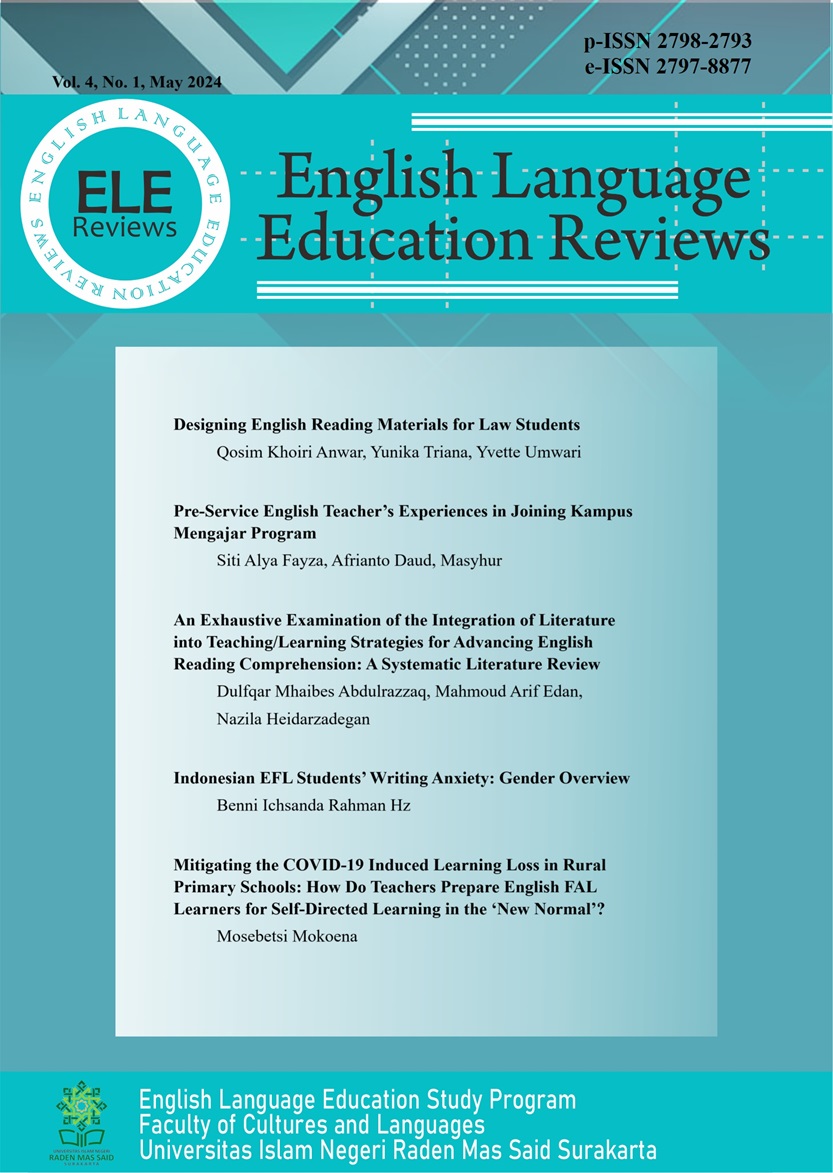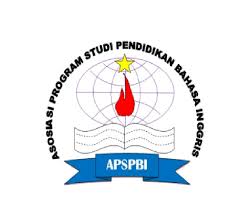Indonesian EFL Students’ Writing Anxiety: Gender Overview
DOI:
https://doi.org/10.22515/elereviews.v4i1.7722Keywords:
anxiety, foreign language, gender, writingAbstract
This study aims to examine the relationship between gender and foreign language writing anxiety among English as a Foreign Language (EFL) pre-service teachers’ students. Utilizing a qualitative case study, the research involved 56 participants, divided equally between male and female students, all enrolled in the English Language Education Study Program at a state university in North Sumatra. A survey of the Second Language Writing Anxiety Scale (SLWAS) was assigned to participants to determine their level of anxiety. To explore how gender, anxiety levels, and students’ experiences and engagement with second/foreign language writing anxiety are connected, the data gathered from the questionnaire were analyzed and grouped according to the participants’ gender. The data analysis shows show that among male respondents, 32.14% experienced high writing anxiety, 64.28% reported moderate anxiety, and 3.58% had low anxiety levels. For female respondents, 39.28% experienced high anxiety, 57.14% reported moderate anxiety, and 3.58% had low anxiety levels. Overall, both male and female participants possess varying levels of writing anxiety, with a higher percentage of females experiencing high anxiety compared to males, although the difference is not significant. More extensive research, incorporating a wider variable, is needed to deepen our understanding of how gender relates to writing anxiety.
Downloads
References
Abu Shawish, J. I., & Abdelraheem, M. A. (2010). An investigation of Palestinian EFL majors’ writing apprehension: Causes and remedies. Online Reports-Research. https://eric.ed.gov/?id=ED512894
Akbari, Z. (2015). Current challenges in teaching/learning English for EFL learners: The case of junior high school and high school. Procedia-Social and Behavioral Sciences, 199, 394-401.
Al-Kubaisy, A. A., Hummadi, A. S., & Turki, H. Y. (2020). Gender differences and the influence of writing anxiety factors on Iraqi postgraduate’s attitudes. In International Conference on English Language and Culture. Koya University
Al Asmari, A. (2013). Investigation of writing strategies, writing apprehension, and writing achievement among Saudi EFL-major students. International Education Studies, 6(11), 130-143. https://doi.org/10.5539/ies.v6n11p130
Aytaç-Demirçivi, K. (2020). Personal factors predicting EFL learners’ writing anxiety. Global Journal of Foreign Language Teaching, 10(4), 257-267. https://doi.org/10.18844/gjflt.v10i4.5104
Baxter, P., & Jack, S. (2008). Qualitative case study methodology: Study design and implementation for novice researchers. The Qualitative Report, 13(4), 544-559. https://doi.org/10.46743/2160-3715/2008.1573
Bloom, L. Z. (1985). Anxious writers in context: Graduate school and beyond. In M. Rose (Ed.), When a Writer Can’t Write: Studies in Writer's Block and Other Composing Problems. (pp. 119-133). The Guilford Press.
Brown, H. D. (2000). Principles of language learning and teaching (4th ed.). Longman.
Celce-Murcia, M., & Olshtain, E. (2000). Discourse and context in language teaching: A guide for language teachers. Cambridge University Press.
Cheng, Y.-S. (2004). A measure of second language writing anxiety: Scale development and preliminary validation. Journal of Second Language Writing, 13(4), 313-335. https://doi.org/10.1016/j.jslw.2004.07.001
Cheng, Y. (2002). Factors associated with foreign language writing anxiety. Foreign Language Annals, 35(6), 647-656. https://doi.org/10.1111/j.1944-9720.2002.tb01903.x
Cheng, Y. S. (2004). EFL students’ writing anxiety: Sources and implications. English Teaching & Learning, 29(2), 41-62.
Cletzer, D. A., Avery, K., & Hasselquist, L. (2022). Supporting students in the writing intensive classroom: Insight on reducing writing apprehension. NACTA Journal, 66.
Cocuk, H. E., Yelken, T. Y., & Omer, O. (2016). The relationship between writing anxiety and writing disposition among secondary school students. Eurasian Journal of Educational Research, 63, 335-352. https://doi.org/10.14689/ejer.2016.63.19
Daud, N. S. M., Daud, N. M., & Kassim, N. L. A. (2005). Second language writing anxiety: Cause or effect? Malaysian Journal of ELT Research, 1(1), 1-19.
Deane, P., Odendahl, N., Quinlan, T., Fowles, M., Welsh, C., & Bivens‐Tatum, J. (2008). Cognitive models of writing: Writing proficiency as a complex integrated skill. ETS Research Report Series, 2008(2), i-36. https://doi.org/10.1002/j.2333-8504.2008.tb02141.x
Hassan, B. A. (2001). The relationship of writing apprehension and self-esteem to the writing quality and quantity of EFL university students. Online Reports-Research. https://eric.ed.gov/?id=ED459671
Huerta, M., Goodson, P., Beigi, M., & Chlup, D. (2017). Graduate students as academic writers: Writing anxiety, self-efficacy and emotional intelligence. Higher Education Research & Development, 36(4), 716-729. https://psycnet.apa.org/doi/10.1080/07294360.2016.1238881
Hz, B. I. R. (2022). Exploring gender differences in public speaking anxiety. Sawwa: Jurnal Studi Gender, 17(2), 247-266. https://doi.org/10.21580/sa.v17i2.14295
Jebreil, N., Azizifar, A., & Gowhary, H. (2015). Investigating the effect of anxiety of male and female Iranian EFL learners on their writing performance. Procedia-Social and Behavioral Sciences, 185, 190-196.
Karakaya, I., & Ulper, H. (2011). Developing a writing anxiety scale and examining writing anxiety based on various variables. Educational Sciences: Theory and Practice, 11(2), 703-707.
Khalil, E. R. (2022). The effect of cognitive strategies on Iraqi EFL college students’ writing anxiety. Journal of the College of Education for Women, 33(4), 27-39. https://doi.org/10.36231/coedw.v33i4.1633
Khosravi, R., Mohammadi, E., Esmaeili, N., & Zandi, H. (2023). Perfectionism and writing anxiety as predictors of Iranian EFL learners’ performance in IELTS writing module: A multi-dimensional perspective. Frontiers in Education, 8, 1108542. https://doi.org/10.3389/feduc.2023.1108542
Kirmizi, Ö., & Kirmizi, G. D. (2015). An investigation of L2 learners’ writing self-efficacy, writing anxiety and its causes at higher education in Turkey. International Journal of Higher Education, 4(2), 57-66. https://doi.org/10.5430/ijhe.v4n2p57
Lahuerta, A. (2020). Analysis of accuracy in the writing of EFL students enrolled on CLIL and non-CLIL programmes: The impact of grade and gender. The Language Learning Journal, 48(2), 121-132. https://doi.org/10.1080/09571736.2017.1303745
Lee, H., & Lee, J. H. (2023). Interpreting the effectiveness of academic English writing programmes in higher education: A meta-analysis. Oxford Review of Education, 49(3), 281-300. https://doi.org/10.1080/03054985.2022.2072284
Lee, S. (2020). Examining the roles of aptitude, motivation, strategy use, language processing experience, and gender in the development of the breadth and depth of EFL learners’ vocabulary knowledge. Sage Journals, 10(4), 2158244020977883. https://doi.org/10.1177/2158244020977883
Liu, S., Seidlitz, J., Blumenthal, J. D., Clasen, L. S., & Raznahan, A. (2020). Integrative structural, functional, and transcriptomic analyses of sex-biased brain organization in humans. Proceedings of the National Academy of Sciences, 117(31), 18788-18798. https://doi.org/10.1073/pnas.1919091117
Martinez, C. T., Kock, N., & Cass, J. (2011). Pain and pleasure in short essay writing: Factors predicting university students’ writing anxiety and writing self‐efficacy. Journal of Adolescent & Adult Literacy, 54(5), 351-360. https://doi.org/10.1598/JAAL.54.5.5
Newman, L. (2012). Sex and gender: Biology, culture, and the expression of gender. In Mental Health and Human Rights: Vision, Praxis, and Courage (pp. 496-504). Oxford University Press. https://doi.org/10.1093/med/9780199213962.003.0034
Onwuegbuzie, A. J. (1999). Writing apprehension among graduate students: Its relationship to self-perceptions. Sage Journals, 84(3), 1034-1039. https://doi.org/10.2466/pr0.1999.84.3.1034
Pappamihiel, N. E. (2002). English as a second language students and English language anxiety: Issues in the mainstream classroom. Research in the Teaching of English, 36. 327-355.
Quvanch, Z., & Si Na, K. (2022). Evaluating Afghanistan University students’ writing anxiety in English class: An empirical research. Cogent Education, 9(1), 2040697. https://doi.org/10.1080/2331186X.2022.2040697
Rahimi, M., & Fathi, J. (2021). Exploring the impact of wiki-mediated collaborative writing on EFL students’ writing performance, writing self-regulation, and writing self-efficacy: A mixed methods study. Computer Assisted Language Learning, 35(9), 2627-2674. https://doi.org/10.1080/09588221.2021.1888753
Rasool, U., Qian, J., & Aslam, M. Z. (2023). An investigation of foreign language writing anxiety and its reasons among pre-service EFL teachers in Pakistan. Frontiers in Psychology, 13, 947867. https://doi.org/10.3389/fpsyg.2022.947867
Razak, N. A., Yassin, A. A., & Maasum, T. N. R. B. T. M. (2017). Effect of Foreign Language Anxiety on Gender and Academic Achievement among Yemeni University EFL Students. English Language Teaching, 10(2), 73-85.
Rezaei, M., & Jafari, M. (2014). Investigating the levels, types, and causes of writing anxiety among Iranian EFL students: A mixed method design. Procedia-Social and Behavioral Sciences, 98, 1545-1554.
Rodríguez, Y., Delgado, V., & Colón, J. M. (2009). Foreign language writing anxiety among preservice EFL teachers. Lenguas Modernas, 33, 21-31.
Sabir, M. S. A., Sharif, H., & Farooq, H. B. (2022). Writing anxiety and intrinsic motivation in English as a foreign language of undergraduates in Pakistan. Journal of Positive School Psychology, 6(12), 1925-1939.
Santrock, J. W. (2017). Life-Span Development (16th ed.). McGraw-Hill.
Shang, H.-F. (2013). Factors associated with English as a foreign language university students writing anxiety. International Journal of English Language Teaching, 1(1), 1-12.
Warschauer, M. (2010). Invited commentary: New tools for teaching writing. Language Learning & Technology, 14(1), 3-8. http://llt.msu.edu/vol14num1/commentary.pdf
Wynne, C., Guo, Y.-J., & Wang, S.-C. (2014). Writing anxiety groups: A creative approach for graduate students. Journal of Creativity in Mental Health, 9(3), 366-379. https://doi.org/10.1080/15401383.2014.902343
Downloads
Published
How to Cite
Issue
Section
Citation Check
License
Copyright (c) 2024 Benni Ichsanda Rahman Hz

This work is licensed under a Creative Commons Attribution-NonCommercial 4.0 International License.
Authors retain copyright and grant the journal right of first publication with the work simultaneously licensed under a Creative Commons Attribution License that allows others to share the work with an acknowledgement of the work's authorship and initial publication in this journal.
This ejournal system and its contents are licensed under
a Creative Commons Attribution-NonCommercial 4.0 International License








